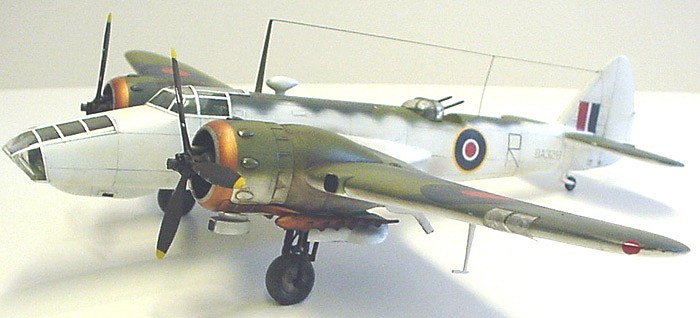
Classic Airframes 1/48 Blenheim V
|
KIT # |
0437 |
|
PRICE: |
100 Swiss Francs (about $66 USD!) |
|
DECALS: |
Three aircraft |
|
REVIEWER: |
|
|
NOTES: |
A very challenging kit |

|
HISTORY |
During the 30’s, the quick development of aircraft technology gave birth to new, revolutionary concepts – and a breed of aeroplanes that were supposed to change the rules of warfare. One of these concepts was the light bomber fast enough to escape enemy interceptors, and that could fly its missions completely unescorted. Britain’s effort, the Bristol Blenheim, was one of the most promising of the lot.
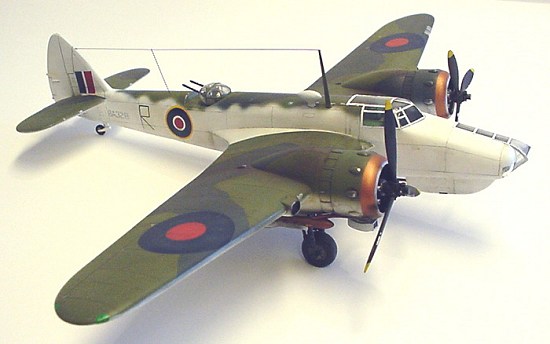 First flown in 1935, in a time
when most nation’s standard fighters still were slow biplanes, the new
British bomber was indeed state-of-the-art. Powered by two 840 hp
Bristol Mercury radials, this sleek all-metal monoplane with a retracting
landing gear could have ruled the skies over Europe – had WWII started 3
years earlier… In 1939, it was a completely different story, as fighter
development had caught up in between, and the speedy light bomber had
become an obsolete death trap for its crews – not speaking of the fighter
version that proved completely unsuitable for the task. Later attempts
to improve the Blenheim Mk I’s speed, protection or cockpit vision
brought little – if any - good. The Mk IV and Mk V (a bomber version of
the Bisley attack plane) were not different enough to change the
situation.
First flown in 1935, in a time
when most nation’s standard fighters still were slow biplanes, the new
British bomber was indeed state-of-the-art. Powered by two 840 hp
Bristol Mercury radials, this sleek all-metal monoplane with a retracting
landing gear could have ruled the skies over Europe – had WWII started 3
years earlier… In 1939, it was a completely different story, as fighter
development had caught up in between, and the speedy light bomber had
become an obsolete death trap for its crews – not speaking of the fighter
version that proved completely unsuitable for the task. Later attempts
to improve the Blenheim Mk I’s speed, protection or cockpit vision
brought little – if any - good. The Mk IV and Mk V (a bomber version of
the Bisley attack plane) were not different enough to change the
situation.
After suffering gruelling losses to the Luftwaffe’s Me 109s and the dreaded German Flak in low-level missions over France, Norway and the English Channel, the Blenheims were withdrawn to secondary fronts like Greece, Somalia or Lybia where they could be put to good use against the Italians – until the Germans joined the battle - , or to less exposed missions like maritime patrol or night interception.
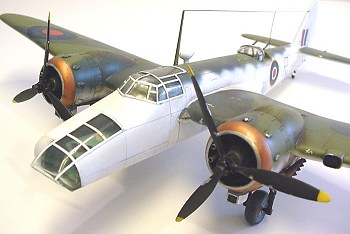 The Blenheim squadrons sent to
South-East Asia had to face the same cruel disillusion as their European
counterparts – they were no match for the Zero and Oscar -, and were
quickly destroyed in the 1941 Japanese onslaught.
The Blenheim squadrons sent to
South-East Asia had to face the same cruel disillusion as their European
counterparts – they were no match for the Zero and Oscar -, and were
quickly destroyed in the 1941 Japanese onslaught.
However, the unfortunate light bomber soldiered on gallantly with the Free French in North Africa and the Finnish Air Force against the Soviets, the Finns keeping theirs well after WWII.
Neutral Turkey and Portugal also used Blenheims, but little is known about their history.
Eventually, the dream of the “bomber-too-fast-to-get-caught” was fulfilled by the DeHavilland Mosquito, but this is another story….
|
THE KIT |
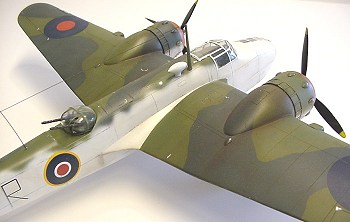 As soon as I saw the strange Mk V
was being released, I wanted to build one (I have a strong taste for
unusual aircraft). True, the Swiss price tag was a horrible sight, but I
had two weeks of summer vacations, no plans to travel abroad, and some
time to spend on a more challenging project… OK, I bought the Mk V.
As soon as I saw the strange Mk V
was being released, I wanted to build one (I have a strong taste for
unusual aircraft). True, the Swiss price tag was a horrible sight, but I
had two weeks of summer vacations, no plans to travel abroad, and some
time to spend on a more challenging project… OK, I bought the Mk V.
At first sight, the contains of the pretty Classic Airframes box seems to be the stuff dreams are made of : fine recessed panel lines, clean and precise resin parts, good transparencies, excellent decals for three interesting versions, an understandable plan… at least, you get something for the money. The difficulties appear later.
|
CONSTRUCTION |
Right, it’s Out of the Box… but I
tell you : superdetailing a Tamigawa kit would be much easier. In the
heat of summer 01, my Blenheim maybe was the most insulted kit in Europe.
At once, two BIG ordeals await the fearless modeller : fitting the resin
walls inside the nose (you sometimes ask yourself if they really were
made for this kit), and sawing off pounds of excess resin from the
landing gear bays (awkwardly molded as bulky blocks) so you can close
the wing halves. Once this is done – my Swiss sense of economy prevented
me from dumping such an expensive kit – the Blenheim builds easily enough
into a 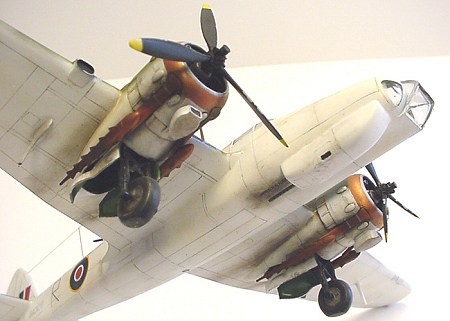 decent representation of the Mk V. Of course, some fitting,
filling, sanding and rescribing will be needed, but this is what
modelling is made of, isn’t it? A good point is the completely
transparent nose, which avoids complicated canopy fitting. The Blenheim
having a frame element on the center-line of the windshield, hiding the
seam won’t be a problem. But more challenges await you underway…
decent representation of the Mk V. Of course, some fitting,
filling, sanding and rescribing will be needed, but this is what
modelling is made of, isn’t it? A good point is the completely
transparent nose, which avoids complicated canopy fitting. The Blenheim
having a frame element on the center-line of the windshield, hiding the
seam won’t be a problem. But more challenges await you underway…
The final details
The next terrible thing you have to do is super-gluing a whole lot of small resin exhaust pipes between the (fine) resin motors and the collector ring (don’t do it before the engines are in their cowlings, the darn pipes WILL break away – and they won’t fit anyway). A pair of curved pliers is absolutely necessary.
Curiously, CA forgot to represent the large landing light in the left wing’s leading edge. This is something you’ll have to make from scratch. The shape of the Frazer Nash turret is quite wrong, but there’s little to be done. On the other hand, small detail parts like the machine-gun barrels and the exhaust pipes are exquisite. The wheels are decent and in “weighted” condition.
|
CAMOUFLAGE & MARKINGS |
Three versions are included :
Free French (North Africa), RAF (SEA) and the one I chose, a machine of
the Royal Hellenic Air Force flying coastal patrol from Aden in 1943,
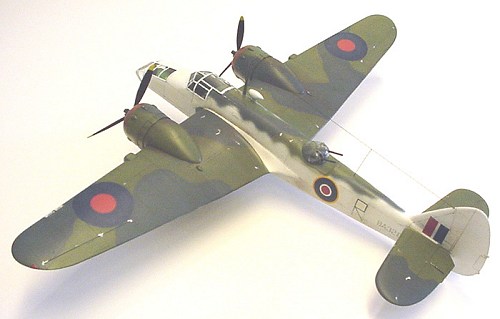 as
I found the coastal command camo was something very special on this
plane. As usual, Tamiya acrylics were self mixed and airbrushed, then
followed by a slight oil wash of terracotta. As the panel lines are a
little too fine for the scale, the wash didn’t work very well and I
underlined them with a soft pencil. The decals went on perfectly. A
little weathering with pastels gave the final touch.
as
I found the coastal command camo was something very special on this
plane. As usual, Tamiya acrylics were self mixed and airbrushed, then
followed by a slight oil wash of terracotta. As the panel lines are a
little too fine for the scale, the wash didn’t work very well and I
underlined them with a soft pencil. The decals went on perfectly. A
little weathering with pastels gave the final touch.
|
CONCLUSIONS |
Here’s a kit I wouldn’t build every month. Once the beast is tamed, however, the result is quite rewarding (“Whaoooow, man, you did the Blenheim !”), and you have the satisfaction of having a very original and handsome plane entering your modeling cabinet. Due to its rather tragical history, the Blenheim is one of the least popular allied planes of WWII (like the Fairey Battle or the Brewster Buffalo, there’s something like a taste of defeat sticking to it), but after all, you can’t build Mosquitoes or P-51’s all the time. There’s a lot of work ahead of you, but nothing that can’t be done. Give it a try if you really, really want a Blenheim in 1/48 scale. Maybe the Mk I or IV are easier – at least from that nose’s point of view… And careful with that superglue !
PS: A few months after finishing my Mk V, I bought MPM’s 1/72 kit. I hate to say that after all this work, but it’s better –even in the details. You lucky “smallscalers” !
|
REFERENCES |
Squadron Signal: “Bristol Blenheim in Action”, Nr. 88.
August 2003
Copyright ModelingMadness.com.
If you would like your product reviewed fairly and fairly quickly, pleasecontact the editor or see other details in the Note to Contributors.
Back to the Reviews Index Page 2020